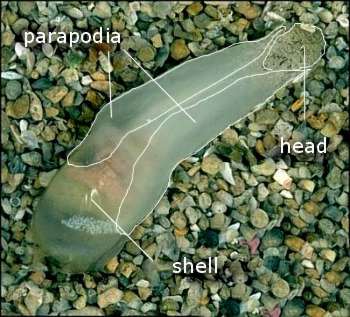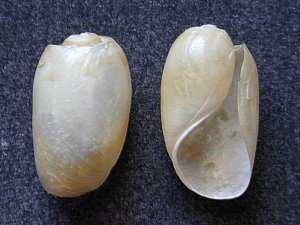

Akeroidea
Order: ANASPIDEA
Superfamily: AKEROIDEA
PHOTO
Upper: Akera soluta showing fragile external shell, parapodial flaps [outlined], and small anterior headshield. Photo: Bill Rudman. Lower: Shell of Akera soluta. 17-19mm long. Photo: Alison Miller.
The Superfamily Akeroidea are primitive relatives of the Sea Hares [Aplysioidea]. Like many primitive opisthobranchs, they have a large external shell, a head lacking any tentacles, and a streptoneurous nervous system [in which the visceral nerve loop is twisted into a figure of 8]. The head is modified for burrowing in soft sediments. Because of its headshield, and bubble-shaped external shell, many scientists considered that the Akeroidea were cephalaspidean bubble-shells rather than Anaspideans. Although Akera usually crawls over, or ploughs through, sand and mud, it can also swim by flapping its large parapodia.
The Akeroidea contains a few species of the genus Akera. Two characters common to both the Akeroidea and the Aplysioidea are the presence in the mantle cavity of an opaline gland (which secretes a colourless smelly fluid) on the floor and the purple gland on the roof (which produces a red or purple coloured ink). A third common feature is the oesophageal gizzard which contains an anterior chamber with large chitinous plates, and a posterior chamber with numerous fine spines.
Authorship detailsRudman, W.B., 2004 (December 22) Akeroidea. [In] Sea Slug Forum. Australian Museum, Sydney. Available from http://www.seaslugforum.net/factsheet/akeroidea
